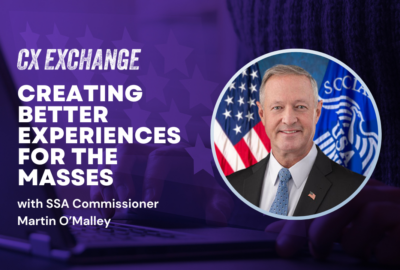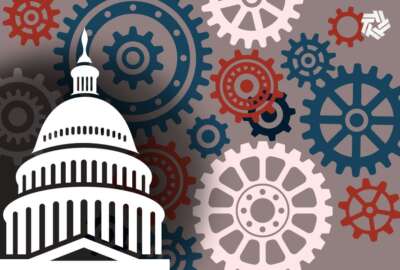Exclusive
SSA leaning into e-signatures as way to cut mountain of mail
SSA is implementing e-signatures capabilities for more than 30 forms and removing the signature requirement altogether for 13 forms.
The Social Security Administration receives about 30 million letters and packages from the Postal Service each year with forms and evidence from citizens applying for services.
Each parcel takes about four minutes to open, scan and process. If you do the math, SSA employees are taking 120 million minutes or 2 million person-hours opening up mail.
SSA is about to take a big bite out of that time and effort by implementing e-signatures capabilities for more than 30 forms and removing the signature requirement altogether for 13 forms. And for SSA, this is just the beginning.

“It’s clear we needed to move on from that world,” said Betsy Beaumon, Social Security’s chief transformation officer, in an exclusive interview with Federal News Network. “Our customers have been telling us we want to be able to do things electronically. We need better ways to communicate with the Social Security Administration. This is one of a number of areas where we’re really focusing on, how do we better communicate with our customers.”
SSA says 90% of the most commonly used forms by its customers now will offer the new e-signature capability.
Beaumon, who runs SSA’s customer experience team, said those 13 forms that no longer require signatures means a reduction by over a million forms a year submitted by mail by citizens. SSA says the forms that no longer require a signature include the Medical Source Opinion of Patient’s Capability to Manage Benefits (Form SSA-787), which has a total annual volume of 768,000, the Letter to Employer Requesting Wage Information (Form SSA-L4201), which has an annual volume of 133,000, and Request for Reconsideration/Disability Cessation Right to Appear (Form SSA-789), which has an annual volume of 49,000.
Additionally, SSA is letting citizens upload more than 70 types of evidence, which also will cut back on the paper forms that need to be mailed.
“This is really part of a bigger move to say we have to meet people where they are, and we have to really let people transact business with us electronically,” Beaumon said. “These are big moves that are really intended to both meet the executive order on customer experience, but more importantly, it’s really meant to make life easier for our customers and for our frontline employees.”
Customer journeys found pain points
Beaumon said SSA’s path to e-signatures and removing the need for signatures altogether started several years ago, but came to the forefront during the pandemic.
She said there were pockets of efforts to implement digital signatures across the agency over the years that never came together.
“Part of what it took is good project management, frankly, to separate the tasks out and make sure that we’re clear,” Beaumon said. “I think there are also multiple parts of this where our customer experience work detailed the journeys of our customers. What we then did is, after doing the initial disability journey with our customer experience team, we really found out that communications was a big challenge. We now had all this additional customer experience input to say, ‘hey, this whole way we communicate with customers in going and outgoing has to really improve.’ The other piece is, of course, doing that incrementally, so making sure everybody knew it was okay to start with a smaller number of forms and keep building upon that. But we had to jump in and make sure that it made sense to our field.”
The other factor that brought this effort together, Beaumon said, was bringing together the lawyers, the technologists, the mission owners and the any other stakeholder to determine the path forward.
In the past, SSA lawyers wanted wet signatures to protect the agency against any threat of lawsuit or complaints.
“When we look at signature removal, we literally came up with a whole new process, and the first step was, let’s get with our lawyers and our whole anti-fraud team and say, ‘Hey, let’s take off the table the forms, at least for now, that you use to really prosecute fraud.’ Let’s make sure we’re keeping the signature,” she said. “Then let’s go through a process with our policy team, our legal team, our operations team and our overall quality review team to look at what is the risk for the other forms. This is a big mindset change.”
SSA already seeing 80% satisfaction rate
A big part of the Office of Transformation’s mission is to analyze risks and push for changes where the agency can manage and mitigate those challenges.
Beaumon said her team brought all the stakeholders together to talk through the ramifications of removing signatures. Oftentimes in the past, the only considerations from agency leaders was what would happen if the citizen didn’t sign the form, but not what if SSA removed the requirement and how that would impact the citizen and agency employee.
“Now we really were looking at the balance of all those things and saying, if it’s a low risk to have it unsigned and it’s going to make it easier on millions of forms, let’s do that. That was really a big example of a process approach that was different than what SSA has done, as far as I know, any time in the past,” Beaumon said. “On the technology side, as far as e-signature, it was looking at multiple paths. There are appointed representatives we work with who today do use commercially signature packages, and so we allow them to use those. In other cases, it makes the most sense, and we can control for our consumers, especially our end customers, a click to sign. We actually developed a click-to-sign path that for the first step.”
Field representatives working with a customer in person or on the phone can email them a link and the citizen can upload documents and digitally sign the form on those more than 30 different online documents.
Beaumon said in the short time since SSA started using e-signatures, the feedback has been positive with a more than 80% customer satisfaction rate.
“We are going to more than double the number of forms that we’re removing signatures on in the very near future,” she said. “One of the really important things that we have started down the path on is making sure that those new forms are web forms. We started with fillable PDFs that can be challenging on some mobile devices if you don’t have the right software. So we’re pushing all of these toward just essentially web fillable forms. The first one we did is one of our absolutely highest volume forms, and that is the SSA 827, where basically somebody is saying, ‘yes, you can look at my medical records for my claim.’ That’s a really key one. The 827 alone is about 31% of the top 10 signed forms coming into field offices every year.”
Transformation continues across SSA
The e-signature initiative and push to remove signatures altogether is one piece to SSA’s broader transformation effort. SSA says it is expanding paperless communication options for the millions of my Social Security users so they can see their online Social Security Statement, track the status of their claims and calculate potential retirement benefits.
The agency also says new my Social Security account holders can choose online-only communications with one click, and others are encouraged to transition for an enhanced experience.
Another piece to this effort is the transition to the General Services Administration’s Login.gov platform. SSA is transitioning all users who made their accounts before 2021 to the Login.gov platform. Any beneficiary who already has a Login.gov account doesn’t need to take any action. More than five million customers have already made the switch. SSA says the change aims to simplify the sign-in process, while providing more secure access to online services.
“Across forms that Americans use most often, we’re eliminating as many pain points as possible, from helping people sign at the click of a button to reducing the need to drive or mail something in whenever possible,” said Martin O’Malley, commissioner of Social Security, in a release. “This means faster and more error-free processing and better service for our customers, who deserve a government that meets their needs efficiently and effectively.”
Copyright © 2024 Federal News Network. All rights reserved. This website is not intended for users located within the European Economic Area.
Jason Miller is executive editor of Federal News Network and directs news coverage on the people, policy and programs of the federal government.
Follow @jmillerWFED







